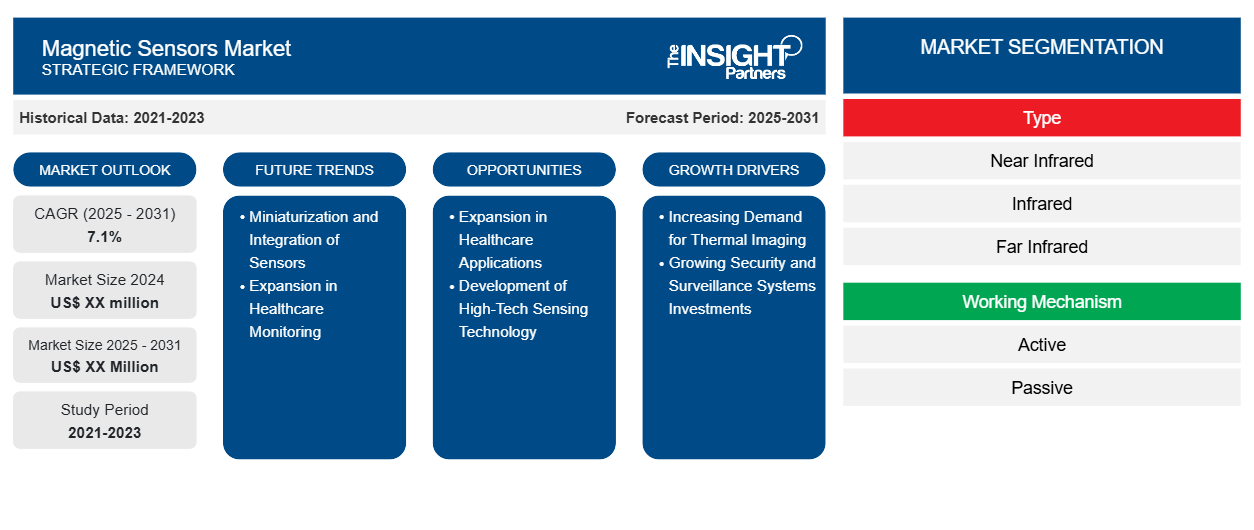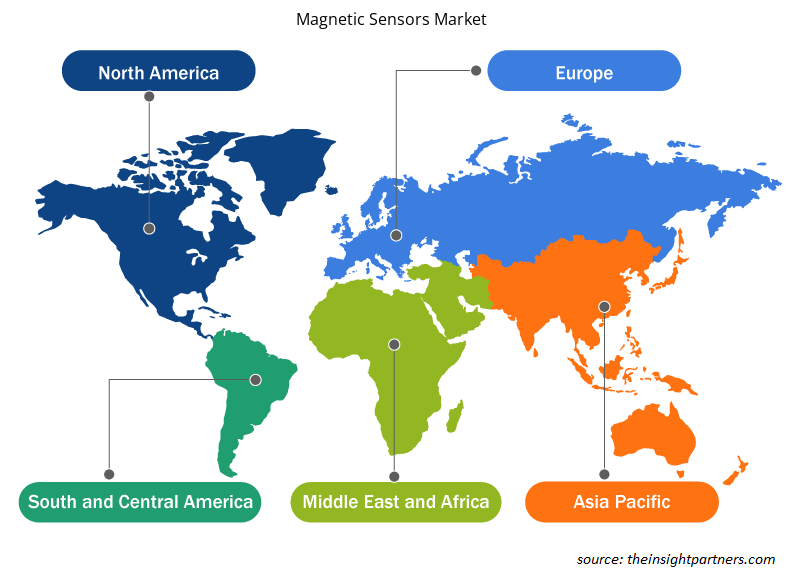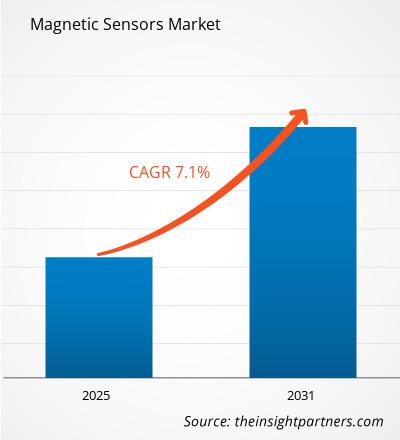The Infrared Sensor Market is expected to register a CAGR of 7.1% from 2025 to 2031, with a market size expanding from US$ XX million in 2024 to US$ XX Million by 2031.
The report is segmented by Type (Near Infrared (NIR), Infrared, and Far Infrared (FIR)); Working Mechanism (Active, Passive); End-User Industry (Healthcare, Aerospace and Defense, Automotive, Commercial Applications, Manufacturing, Oil and Gas, Others); Geography (North America, Europe, Asia-Pacific, Middle East & Africa, South and Central America).
The global analysis is further broken-down at regional level and major countries. The report offers the value in USD for the above analysis and segments
Purpose of the Report
The report Infrared Sensor Market by The Insight Partners aims to describe the present landscape and future growth, top driving factors, challenges, and opportunities. This will provide insights to various business stakeholders, such as:
- Technology Providers/Manufacturers: To understand the evolving market dynamics and know the potential growth opportunities, enabling them to make informed strategic decisions.
- Investors: To conduct a comprehensive trend analysis regarding the market growth rate, market financial projections, and opportunities that exist across the value chain.
- Regulatory bodies: To regulate policies and police activities in the market with the aim of minimizing abuse, preserving investor trust and confidence, and upholding the integrity and stability of the market.
Infrared Sensor Market Segmentation
Type
- Near Infrared
- Infrared
- Far Infrared
Working Mechanism
- Active
- Passive
End-User Industry
- Healthcare
- Aerospace and Defense
- Automotive
- Commercial Applications
- Manufacturing
- Oil and Gas
- Others
Geography
- North America
- Europe
- Asia-Pacific
- South and Central America
- Middle East and Africa
You will get customization on any report - free of charge - including parts of this report, or country-level analysis, Excel Data pack, as well as avail great offers and discounts for start-ups & universities
Magnetic Sensors Market: Strategic Insights

- Get Top Key Market Trends of this report.This FREE sample will include data analysis, ranging from market trends to estimates and forecasts.
Infrared Sensor Market Growth Drivers
- Increasing Demand for Thermal Imaging: Thermal imaging technology is in increasing demand, representing a significant driver for the infrared sensor market. The technology has widespread application areas, including security and surveillance, building inspection, and medical diagnostics. As industries seek to improve safety and efficiency, accurate solutions for thermal imaging are in greater demand. This trend is more pronounced in areas such as healthcare, where infrared sensors are used for non-invasive temperature monitoring and diagnostics, and in security applications where intruders can be detected in low light conditions.
- Growing Security and Surveillance Systems Investments: The growing investment in security and surveillance systems is a strong driver for the infrared sensor market. The demand for advanced surveillance technologies has increased with the growing safety and security concerns in both the public and private sectors. Modern security systems are not complete without the infrared sensors, as they can offer facilities such as motion detection and night vision. The adoption of infrared sensors in surveillance applications is a further trend that further leads to market growth in smart cities as well as in enhanced public safety measures.
Infrared Sensor Market Future Trends
- Miniaturization and Integration of Sensors: Another trend experienced in the infrared sensor market is miniaturization and integration of sensing technologies. In this pursuit, as devices are shrinking and becoming smaller, there is an increased demand for miniature infrared sensors that can be accommodated within limited space without accepting degraded performance. This will be particularly true in consumer electronics and in wearable devices where size and weight become an influencing factor. Manufacturers are working towards producing miniaturized infrared sensors with high levels of sensitivity and accuracy so that they can meet the demands of high-tech applications.
- Expansion in Healthcare Monitoring: The demand for infrared sensors in healthcare applications will rise, especially in non-contact temperature measurement and health monitoring devices. These sensors will be critical for fever detection, monitoring vital signs, and supporting remote health diagnostics, particularly in managing pandemics and ensuring patient safety in hospitals and clinics.
Infrared Sensor Market Opportunities
- Expansion in Healthcare Applications: Considerable opportunities exist in the healthcare sector for infrared sensors. As the importance of remote patient monitoring and telehealth solutions continues to grow, using infrared sensors for noncontact temperature measurement and diagnostic purposes will be a must. Following COVID-19, all these technologies have been adopted at rocketing speeds. Health monitoring requires accurate and reliable solutions. Companies who develop innovative infrared sensing technologies that are specifically suited to healthcare applications are sure to find an attractive segment to tap.
- Development of High-Tech Sensing Technology: There is a tremendous scope for the development of more advanced infrared sensing technologies, including multi-spectral and hyperspectral sensors. In such technologies, there are enhanced capabilities in several different applications, like environmental surveillance, agriculture, and industrial automation. While investing in research and development, the corporations can come up with high-tech infrared sensors that suit the changing demands of various industries to become a winner in the business market.
Magnetic Sensors Market Regional Insights
The regional trends and factors influencing the Magnetic Sensors Market throughout the forecast period have been thoroughly explained by the analysts at Insight Partners. This section also discusses Magnetic Sensors Market segments and geography across North America, Europe, Asia Pacific, Middle East and Africa, and South and Central America.

- Get the Regional Specific Data for Magnetic Sensors Market
Magnetic Sensors Market Report Scope
| Report Attribute | Details |
|---|---|
| Market size in 2024 | US$ XX million |
| Market Size by 2031 | US$ XX Million |
| Global CAGR (2025 - 2031) | 7.1% |
| Historical Data | 2021-2023 |
| Forecast period | 2025-2031 |
| Segments Covered |
By Type
|
| Regions and Countries Covered | North America
|
| Market leaders and key company profiles |
Magnetic Sensors Market Players Density: Understanding Its Impact on Business Dynamics
The Magnetic Sensors Market is growing rapidly, driven by increasing end-user demand due to factors such as evolving consumer preferences, technological advancements, and greater awareness of the product's benefits. As demand rises, businesses are expanding their offerings, innovating to meet consumer needs, and capitalizing on emerging trends, which further fuels market growth.
Market players density refers to the distribution of firms or companies operating within a particular market or industry. It indicates how many competitors (market players) are present in a given market space relative to its size or total market value.
Major Companies operating in the Magnetic Sensors Market are:
- Asahi Kasei Microdevices Corporation
- Silicon Austria Labs GmbH
- Honeywell International Inc.
- Infineon Technologies AG
- KOHSHIN ELECTRIC CORPORATION
- Melexis
Disclaimer: The companies listed above are not ranked in any particular order.

- Get the Magnetic Sensors Market top key players overview
Key Selling Points
- Comprehensive Coverage: The report comprehensively covers the analysis of products, services, types, and end users of the Infrared Sensor Market, providing a holistic landscape.
- Expert Analysis: The report is compiled based on the in-depth understanding of industry experts and analysts.
- Up-to-date Information: The report assures business relevance due to its coverage of recent information and data trends.
- Customization Options: This report can be customized to cater to specific client requirements and suit the business strategies aptly.
The research report on the Infrared Sensor Market can, therefore, help spearhead the trail of decoding and understanding the industry scenario and growth prospects. Although there can be a few valid concerns, the overall benefits of this report tend to outweigh the disadvantages.
Frequently Asked Questions
What is the expected CAGR of the Infrared Sensor Market?
The Infrared Sensor Market is estimated to witness a CAGR of 7.1% from 2023 to 2031
What are the driving factors impacting the global Infrared Sensor Market?
Increasing Demand for Thermal Imaging and Growing Security and Surveillance Systems Investments are the major factors driving the Infrared Sensor Market
What are the options available for the customization of this report?
Some of the customization options available based on the request are an additional 3-5 company profiles and country-specific analysis of 3-5 countries of your choice. Customizations are to be requested/discussed before making final order confirmation# as our team would review the same and check the feasibility
What are the future trends of the Infrared Sensor Market?
Miniaturization and Integration of Sensors is anticipated to play a significant role in the global Infrared Sensor Market in the coming years
What are the deliverable formats of the market report?
The report can be delivered in PDF/PPT format; we can also share excel dataset based on the request
- Historical Analysis (2 Years), Base Year, Forecast (7 Years) with CAGR
- PEST and SWOT Analysis
- Market Size Value / Volume - Global, Regional, Country
- Industry and Competitive Landscape
- Excel Dataset
Testimonials
Reason to Buy
- Informed Decision-Making
- Understanding Market Dynamics
- Competitive Analysis
- Identifying Emerging Markets
- Customer Insights
- Market Forecasts
- Risk Mitigation
- Boosting Operational Efficiency
- Strategic Planning
- Investment Justification
- Tracking Industry Innovations
- Aligning with Regulatory Trends
Yes! We provide a free sample of the report, which includes Report Scope (Table of Contents), report structure, and selected insights to help you assess the value of the full report. Please click on the "Download Sample" button or contact us to receive your copy.
Absolutely — analyst assistance is part of the package. You can connect with our analyst post-purchase to clarify report insights, methodology or discuss how the findings apply to your business needs.
Once your order is successfully placed, you will receive a confirmation email along with your invoice.
• For published reports: You’ll receive access to the report within 4–6 working hours via a secured email sent to your email.
• For upcoming reports: Your order will be recorded as a pre-booking. Our team will share the estimated release date and keep you informed of any updates. As soon as the report is published, it will be delivered to your registered email.
We offer customization options to align the report with your specific objectives. Whether you need deeper insights into a particular region, industry segment, competitor analysis, or data cut, our research team can tailor the report accordingly. Please share your requirements with us, and we’ll be happy to provide a customized proposal or scope.
The report is available in either PDF format or as an Excel dataset, depending on the license you choose.
The PDF version provides the full analysis and visuals in a ready-to-read format. The Excel dataset includes all underlying data tables for easy manipulation and further analysis.
Please review the license options at checkout or contact us to confirm which formats are included with your purchase.
Our payment process is fully secure and PCI-DSS compliant.
We use trusted and encrypted payment gateways to ensure that all transactions are protected with industry-standard SSL encryption. Your payment details are never stored on our servers and are handled securely by certified third-party processors.
You can make your purchase with confidence, knowing your personal and financial information is safe with us.
Yes, we do offer special pricing for bulk purchases.
If you're interested in purchasing multiple reports, we’re happy to provide a customized bundle offer or volume-based discount tailored to your needs. Please contact our sales team with the list of reports you’re considering, and we’ll share a personalized quote.
Yes, absolutely.
Our team is available to help you make an informed decision. Whether you have questions about the report’s scope, methodology, customization options, or which license suits you best, we’re here to assist. Please reach out to us at sales@theinsightpartners.com, and one of our representatives will get in touch promptly.
Yes, a billing invoice will be automatically generated and sent to your registered email upon successful completion of your purchase.
If you need the invoice in a specific format or require additional details (such as company name, GST, or VAT information), feel free to contact us, and we’ll be happy to assist.
Yes, certainly.
If you encounter any difficulties accessing or receiving your report, our support team is ready to assist you. Simply reach out to us via email or live chat with your order information, and we’ll ensure the issue is resolved quickly so you can access your report without interruption.















The List of Companies
1. Allegro MicroSystems, LLC
2. ams AG
3. Asahi Kasei Microdevices Corporation
4. HONEYWELL INTERNATIONAL INC.
5 .Infineon Technologies AG
6. Melexis
7. Murata Manufacturing Co., Ltd.
8. NVE Corporation
9. NXP Semiconductors
10. TE Connectivity






 Get Free Sample For
Get Free Sample For